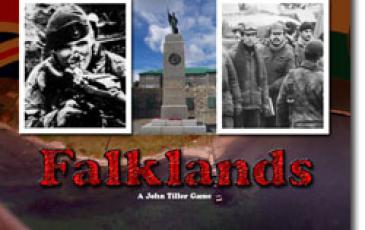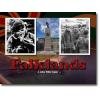Operation Mikado,Pink Panther in Action - Falklands

 0 - 0 - 0
0 - 0 - 0

| Rating: | 0 (0) |
| Games Played: | 0 |
| SM: | 4 |
| Turns: | 20 |
| Type: | Stock |
| First Side: | UK |
| Second Side: | Argentina |
Company Level
Normal Night Conditions
Hypothetical Scenario
Play as British or PBEM
The sinking of HMS Sheffield by an Exocet missile showed how vulnerable the British fleet was to air launched missile attack. Fortunately for the British, the Argentines had a limited number of missiles and planes that could launch them. With a little assistance from the Americans, British Intelligence was able to determine that the French built Super Etendard strike planes were based at Rio Grande in Tierra del Fuego. As Exocet fear grew in the British command at Norwood, plans to try and degrade Argentina's ability to launch missile attacks were suggested. An airstrike on the Argentine mainland was possible, but it would take all of the tanker resources available to get a single Vulcan bomber over the target. This type of attack had been launched against the airfield at Port Stanley with only limited success. Rio Grande was a much more substantial airport with better defenses. A Harrier strike could be launched, but it would require the British carriers to close on the mainland and make them very vulnerable to air attack. The plan with the highest chance of success appeared to be a night raid by special forces, but even this was rife with potential disasters.
The Argentines also realized the value of the Rio Grande airbase and went to great lengths to defend it. Elements of three Infanteria de Marina battalions were deployed in the area. These units included armored cars and amphibious, armored personnel carriers. An extensive minefield was placed around the airport. The Marines suspected that the British might try to launch a raid and they fortified the perimeter around the field. Only a single platoon was actually stationed on the airfield, however.
The British envisioned the best chance for success to be similar to the Israeli raid on Entebbe. The raid was codenamed Operation Mikado. Two C-130 transport planes would load B Squadron of the SAS and their Pink Panther vehicles. They would fly a circuitous route and approach Rio Grande low and from the west to avoid radar detection. The planes would crash land on the runway, releasing the SAS to wreck havoc on the planes, pilots and weapons stationed at the airfield. However, they had almost no information on where any of these targets were located. In preparation for the raid, a reconnaissance element was loaded aboard a stripped down Sea King and launched towards the mainland. The helicopter was spotted by radar and the commander of the recon element elected to abort the mission. The helicopter landed in nearby Chile as planned while the SAS troopers who had landed avoided the Argentine patrols looking for them and made it to Chile on foot. The British were still determined to go ahead with the plan even without intelligence about the airfield. The men were on their way to Ascension Island when they learned of the catastrophic helicopter crash in the South Atlantic that claimed the lives of nineteen SAS troopers. The raid was finally called off and B Squadron was used to replace the losses incurred.
This scenario assumes the helicopter crash hasn't occurred yet and that the recon element has managed to infiltrate the airbase and provide a limited amount of intelligence back to their comrades. The troopers would emerge from their hides to knock out the powerlines and backup generator right before the C-130s landed, pitching the base into confusion and darkness. The SAS's motto is "He who dares, wins" and this would be the ultimate test of that theory.
Note - There are 190 points of hidden objectives for the British player to locate and capture. This is due to the lack of available intelligence before the mission was launched. The two C-130s may only enter hard and open hexes due to their large wingspan. Only the C-130s, and any units loaded on them may use the exit objectives on the east end of the runway. Any other British unit needs to use the objective hexes in the northwest corner of the map.
Normal Night Conditions
Hypothetical Scenario
Play as British or PBEM
The sinking of HMS Sheffield by an Exocet missile showed how vulnerable the British fleet was to air launched missile attack. Fortunately for the British, the Argentines had a limited number of missiles and planes that could launch them. With a little assistance from the Americans, British Intelligence was able to determine that the French built Super Etendard strike planes were based at Rio Grande in Tierra del Fuego. As Exocet fear grew in the British command at Norwood, plans to try and degrade Argentina's ability to launch missile attacks were suggested. An airstrike on the Argentine mainland was possible, but it would take all of the tanker resources available to get a single Vulcan bomber over the target. This type of attack had been launched against the airfield at Port Stanley with only limited success. Rio Grande was a much more substantial airport with better defenses. A Harrier strike could be launched, but it would require the British carriers to close on the mainland and make them very vulnerable to air attack. The plan with the highest chance of success appeared to be a night raid by special forces, but even this was rife with potential disasters.
The Argentines also realized the value of the Rio Grande airbase and went to great lengths to defend it. Elements of three Infanteria de Marina battalions were deployed in the area. These units included armored cars and amphibious, armored personnel carriers. An extensive minefield was placed around the airport. The Marines suspected that the British might try to launch a raid and they fortified the perimeter around the field. Only a single platoon was actually stationed on the airfield, however.
The British envisioned the best chance for success to be similar to the Israeli raid on Entebbe. The raid was codenamed Operation Mikado. Two C-130 transport planes would load B Squadron of the SAS and their Pink Panther vehicles. They would fly a circuitous route and approach Rio Grande low and from the west to avoid radar detection. The planes would crash land on the runway, releasing the SAS to wreck havoc on the planes, pilots and weapons stationed at the airfield. However, they had almost no information on where any of these targets were located. In preparation for the raid, a reconnaissance element was loaded aboard a stripped down Sea King and launched towards the mainland. The helicopter was spotted by radar and the commander of the recon element elected to abort the mission. The helicopter landed in nearby Chile as planned while the SAS troopers who had landed avoided the Argentine patrols looking for them and made it to Chile on foot. The British were still determined to go ahead with the plan even without intelligence about the airfield. The men were on their way to Ascension Island when they learned of the catastrophic helicopter crash in the South Atlantic that claimed the lives of nineteen SAS troopers. The raid was finally called off and B Squadron was used to replace the losses incurred.
This scenario assumes the helicopter crash hasn't occurred yet and that the recon element has managed to infiltrate the airbase and provide a limited amount of intelligence back to their comrades. The troopers would emerge from their hides to knock out the powerlines and backup generator right before the C-130s landed, pitching the base into confusion and darkness. The SAS's motto is "He who dares, wins" and this would be the ultimate test of that theory.
Note - There are 190 points of hidden objectives for the British player to locate and capture. This is due to the lack of available intelligence before the mission was launched. The two C-130s may only enter hard and open hexes due to their large wingspan. Only the C-130s, and any units loaded on them may use the exit objectives on the east end of the runway. Any other British unit needs to use the objective hexes in the northwest corner of the map.





















